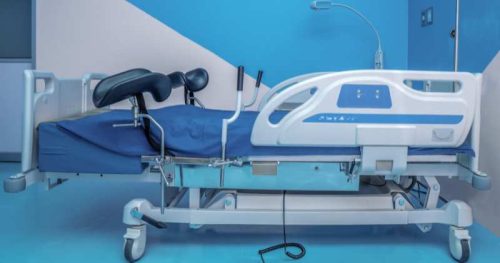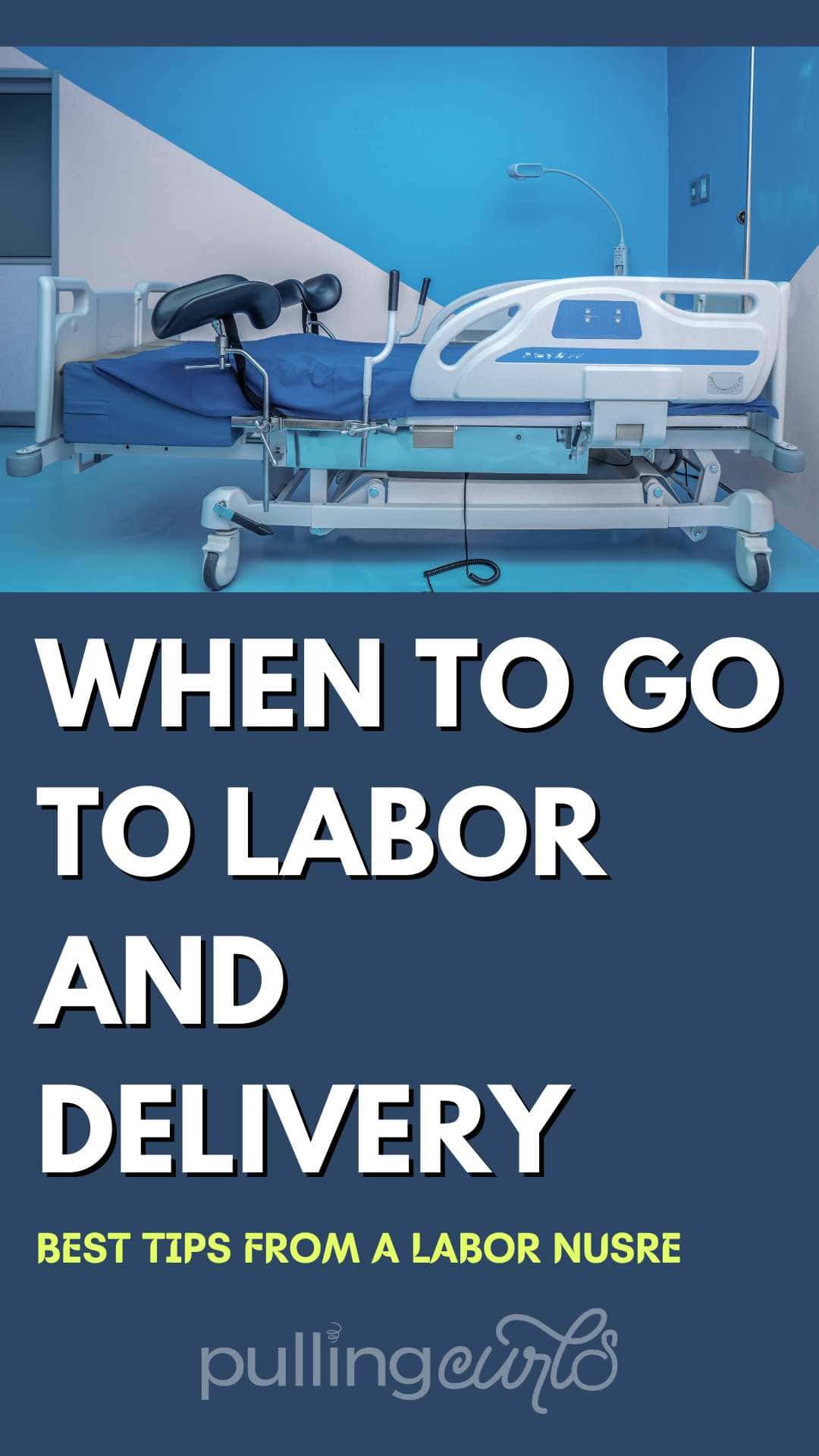Going to labor and delivery can be confusing. Not only do you know where to park, or enter — do you stop by the emergency room first, it’s hard to say. Today I want to share some of the top reasons you’ll want to head into labor and delivery for. And, not all of them are labor, so we’ll try to keep this simple.

Hi, I’m Hilary, The Pregnancy Nurse® — I have to say that before I worked in labor and delivery (nurse since 1997 and I have 20 years of L&D experience), I didn’t quite understand how labor and delivery worked (I’ll share some of my mistakes in this article tho). But, it’s important that YOU understand how you can use it, and I hope this article will do just that.
Let’s quickly talk about labor and delivery, the unit. Most people think it is only a place for delivering a baby. But, that’s not true at all. Labor and delivery is the spot for almost anything that happens to a pregnant person in the hospital. Most hospitals have every patient who has anything that isn’t imminently life-threatening be sent to labor and delivery where we are trained and able to monitor both mom and baby to make sure we can help both of them.
So, it is basically the ER for pregnant people, so we see LOTS of things that aren’t labor. I have a whole post on at what point in pregnancy you go to labor and delivery vs the er.
Many people don’t know there are a lot of reasons why you might need to go to the hospital during pregnancy besides just contractions. We’re going to split this up in to reasons to go to the hospital besides contractions. and also when to go when you’re in active labor.
If you’re more interested in these items, I actually dive into the more in my free prenatal class. It’s all about third trimester testing and when you should consider going to the hospital. And, it’s free. 🙂
Don’t forget if you ever have ANY questions please do call your doctor. They can best advise you on your own personal situation and needs. Most doctors have someone that answers calls for them 24 hours a day for emergencies, so if you think you have one — that’s your best first step.
Reasons to Go to the Labor & Delivery Besides Labor
Please note that this is NOT an exhaustive list, but are some of the most common reasons. If you have ANY questions make sure to call your provider, or just head in if necessary.
Scheduled Procedures
Depending on the labor and delivery unit, they often will schedule procedures like:
- NST’s (non-stress tests)
- BPP’s or other ultrasounds
- PIH labs
- Other stuff. 🙂
In some ways L&D is almost like a doctor’s office, and an ER and where people deliver babies. It’s a very versatile floor.
And we talk about this type of testing in the free prenatal class that I mentioned above, so come join me in there!
Bleeding
If you’re bleeding it is something you should take seriously. If you’re before about 36 weeks of pregnancy, most bleeding should trigger a call to your provider just to make sure things are OK, and they may advise you to go to L&D. I have a post on bleeding at 20 weeks that you might find helpful.
After 36 weeks, as you get closer to your due date, you may spot here and there, but anything that is bright red over the size of a quarter should also trigger a call. I have a post on later pregnancy discharge vs water breaking you might find helpful.
If there’s a lot of bleeding you may even want to consider call 911 for an ambulence or going to L&D without calling your provider (or you can call your provider on your way). This can be a sign of an abruption which is an emergency.
Bleeding can happen for other reasons though too (penetrative sex and a vaginal exam can sometimes cause some spotting). But you’ll want to make sure baby is fine.
If you have complications with your pregnancy like a previa any bleeding may trigger an immediate visit to L&D. So, be sure to take the instructions from your provider seriously.
Contractions Before 36 Weeks
If you’re prior to 36 weeks, you need to take contractions seriously. Be sure to ask your provider how many contractions are OK to have in an hour and when you should either call them or go into labor and delivery.
Bladder or Kidney Pain
If you think you have a bad bladder or kidney infection you may want to go into labor and delivery. Personally, with my first baby I had a doozy of a bladder infection that was causing me to be MISERABLE and waited to see my OB when he opened his office in the morning, when I probably should have gone into Labor and Delivery. Bad kidney or bladder infections, or kidney stones can put you into preterm labor and do need to be taken seriously during pregnancy.
**I would definitely try to take care of as much as possible at your provider’s office if possible. Trips to labor and delivery can trigger an ER copay depending on your insurance, not to mention they tend to be much longer as the hospital will have to do a full assessment and workup.
A Terrible Headache That Won’t Go Away
If you have a horrible headache that won’t go away with tylenol (if your doctor is OK with tylenol), water, food and rest you may want to call your provider and they may recommend you go to labor and delivery. This can be a sign of preeclampisa. They can do testing, including checking your blood pressure and some lab work to see if you have it pretty easily.
Headaches aren’t unusual during pregnancy (some think headaches can be a sign of labor) but terrible ones that don’t go away can be a sign of a big problem.
Decreased Fetal Movement
If baby isn’t moving you should go into labor and delivery. I think that keeping track of your movement with kick counts is best, but if you’re not feeling baby move like they normally do you will want to be seen. Fetal movement is the best indicator of fetal well-being, and the hospital (and you) should take it seriously.
I have a whole post on when to go to the hospital for decreased fetal movement that is super helpful. This is a serious thing guys, and I really want you to be aware of how much your baby is moving!
You Think Your Water is Broken
If you think your water is broken you should be seen. You can also call your provider to get their input. It’s not so much a reason to go in RIGHT away, but your provider will not want your water to be broken long as there is a chance of infection. When your water breaks, call your provider so you guys can talk about your next steps.
I have an Is my water broken quiz that will give you some ideas on what to watch for.
When Should Contractions Take You Into Labor and Delivery
**If you have a planned cesarean delivery, if you feel contractions that should trigger a call to your provider. They would prefer you not be in labor during a cesarean, so this may not apply to those people.
Unless the other things above are happening you want to spend your early labor time at home rather than the hospital. There just really isn’t a reason to be there as long as things are progressing normally and you’re still early in childbirth.
BTW if you’re wondering about the stages of labor, I have a bonus video in here that explains all of it.
Early labor contractions or sometimes false labor (because sometimes early labor stops) or Braxton Hicks contractions can all be lumped into one pile normally with these characteristics:
- Stops and starts
- Stops if you lay down or stops if you start moving
- Stops with hydration
- Don’t become strong or closer together
- Don’t last a minute
- Are just contractions, doesn’t involve other parts of your body
I have a whole post on the signs of labor that you might find helpful as well (because it’s not JUST contractions, often your whole body gets in on the action).
The crazy thing is that early labor can either stop, just stay how it is for a while, or can progress into active labor.
However, if you’re having a lot of the signs of labor, it’s a good time to pack your hospital bag in case you need to head to the hospital soon.
**Don’t forget that early labor can still be quite painful and annoying. It’s still “real labor” it’s just not progressing you towards baby coming out soon — but can, with time.
How to Know if You’re in Active Labor
Active labor is defined as contractions that are actively pushing baby through the cervix into the birth canal (which also causes you to dilate).
While I think it’s a good call to just keep an eye on any contractions, I don’t actually recommend you time your contractions until painful contractions are hard enough to take your breath away (or you can’t talk during, even if you try). Most often you want those type of more intense contractions to be 3-5 minutes apart (closer to 3 if it’s your first baby, closer to 5 if it’s a subsequent baby) before you head in.
Not sure how to time contractions? I walk you through what to watch for in here.
BUT all of that timing really depends on you, your circumstances, the hospital and more. So talk with your provider about what you should be experiencing or if you are just supposed to call them and discuss it when it happens.
It’s confusing, I know — but the good news is that no visit to labor and delivery is wasted. We can be sure that you and baby are doing well and are safe. And, if the best spot for you is at home, you can head back home too.
Just because you go to labor and delivery doesn’t mean you’ll need to stay there, it just depends on what they find. I have a whole post on what to do if you’re sent home from L&D.
I know a lot of people are worried that you will deliver your baby at home, but especially if it is your first baby you have a lot of time between when active labor starts (where those contractions are hard to talk through) to when baby will be born, so give yourself some grace, stay in touch with your provider and don’t worry about going into the hospital if you’re concerned, it’s open 24/7 every day of the year (aka, it never closes).
So, those are some tips on when to go into labor and delivery. I hope you found them helpful! I try to really simplify things as much as possible which is why I created one of the first online prenatal classes, so people could really understand their bodies and labor. Come join me in The Online Prenatal Class for Couples so I can simplify it for you too!
Have you checked a birth class off your to do list✅? I have a few I recommend:
❤️ Best class for couples {per BabyList}
👩💻 Best class available on demand
⚡ Best class JUST for pain management
👶 Best Postpartum-Only Prep
❤️🧡💛💚💙💜 My favorite class is here.
Now is the time to get started!
Or, if you’re not quite ready for the full class, check out my free prenatal class — It’s your first step towards being your own birth boss.










Leave a Reply